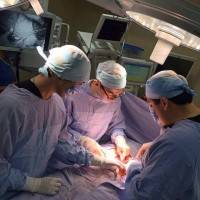Ventral hernia diagnosis
Clinical Examination Is Essential
In most cases, it is relatively straight forward to differentiate between a diastasis and a true hernia based on physical examination.
Exceptions are patients who are significantly overweight or have had multiple prior surgeries.
In those cases a CT scan is the best way to identify a ventral hernia. (Lawrence Iteld, MD, Chicago Plastic Surgeon)
Diagnosing a Ventral Hernia
Usually hernias can be diagnosed on physical exam. In heavier patients, or those with prior abdominal surgeries I will often obtain a CT scan of the abdomen as a “roadmap” for surgery and also to define the extent of the defect and reveal any other areas of weakness that may also exist. (John LoMonaco, MD, FACS, Houston Plastic Surgeon)
Testing for a ventral hernia before tummy tuck
Diastasis of the abdominal muscles is a very common finding and easy to feel on examination. All the normal layers of the abdominal wall are present and a diastasis is not a hernia.
A ventral hernia is an opening in the muscle or the covering layer called fascia which can also be felt on an examination of abdomen.
If there is a doubt as to whether a hernia is present, an CT scan, or an MRI scan will clear matters up and help your surgeon prepare. Best of luck, peterejohnsonmd (Peter E. Johnson, MD, Chicago Plastic Surgeon)
Rectus diastasis vs. ventral hernia – what’s the difference?
A rectus diastasis is simply separation of the rectus abdominis muscles away from the midline- the ‘bridge’ between the two muscle bundles is a thin band of connective tissue which can bulge.
This is not a true hernia, since there is no ‘hole’ in the connective tissue of the abdominal wall. Such a hole can allow abdominal contents (fat, bowel etc) and to enter- this is a hernia sac.
The contents of a hernia sac can be entrapped, strangulated, or can just progressively enlarge over time. A rectus diastasis poses no risk of entrapment, and is therefore not considered a diagnosis covered by insurance companies. (Scott C. Sattler, MD, FACS, Seattle Plastic Surgeon)
Ventral Hernia
The best way to diagnose a ventral hernia is through physical exam. The surgeon can feel the edges of the ventral fascial defect. Another way to make this diagnosis is through a CT or MRI scan of the abdomen – demonstrating a herniaton of abdominal contents through the ventral fascia. (Daniel Reichner, MD, Newport Beach Plastic Surgeon)
VENTRAL HERNIA DIAGNOSIS
A true hernia is essentially an anatomical diagnosis made predominantly by physical exam. Your surgeon should be trained in distinguishing a diastasis (separation) from a hernia (fascial defect). Usually he/she can feels an edge to the fascia around the area of weakness. (Robin T.W. Yuan, MD, Beverly Hills Plastic Surgeon)







